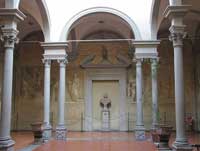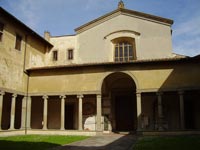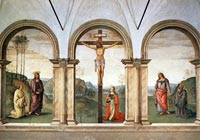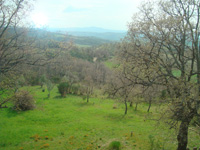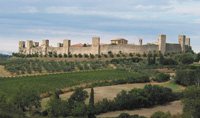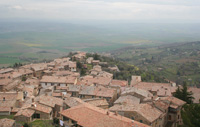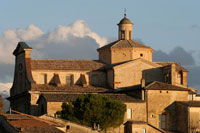The Duomo, Santa Maria del Fiore
|
East
|
West
|
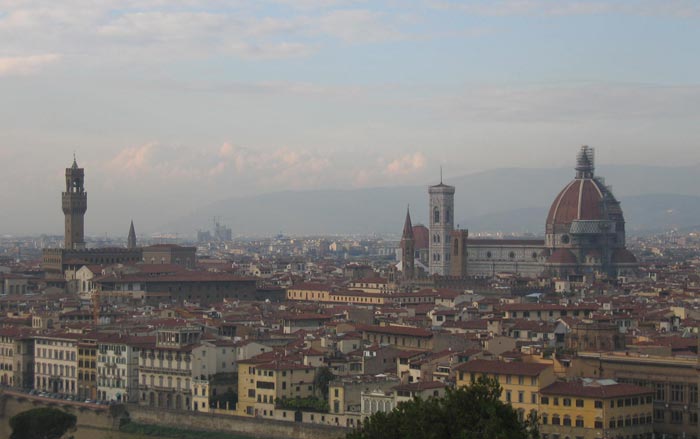 |
|
Florence
|
|
Churches, cathedrals, basilicas and monasteries of Florence |
Florence lies on the Arno River and it is known for its history and its importance in the Middle Ages and in the Renaissance, especially for its art and architecture. A centre of medieval European trade and finance, the city is often considered the birthplace of the Italian Renaissance and was long ruled by the Medici family. In fact, the city has been called the Athens of the Middle Ages. Just here, in the XV century, were put the basis to flourish again the Italian art and culture: thanks to writers like Dante, Petrarca and Machiavelli, the Italian language was born and thanks to the operas of artists like Botticelli, Michelangelo, Donatello, Brunelleschi and many others, it is become one of the artistic capital of the world. The "Historic Centre of Florence" was declared a World Heritage Site by the UNESCO in 1982.
|
|
|
|
| View Firenze churches in a larger map | Map of the churches, cathedrals, basilicas and monasteries of Florence, Italy
|
The Duomo, Santa Maria del Fiore |
||
Santa Maria del Fiore, or the Duomo, is the cathedral church of Florence, dedicated to the Madonna of Florence. The famous cathedral dominates the skyline of Florence, with its eight white ribs against a background of terracotta tiles. The basilica is one of the largest churches in Italy and until the modern era, the dome was the largest in the world. It remains the largest brick dome ever constructed. The church's three buildings form part of the UNESCO World Heritage Site covering the historic center of Florence.
|
||
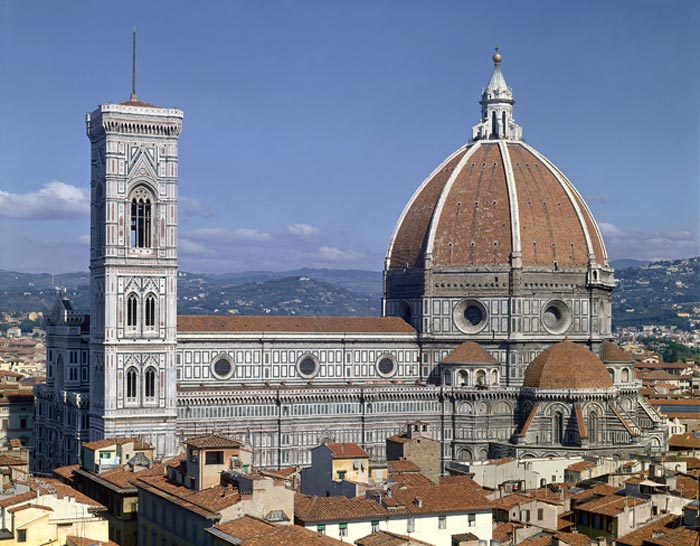 |
||
Firenze, Duomo |
||
The colorful exterior walls are made from marble; white from Carrara, green from Prato, and red from Maremma. The duomo is composed of the cathedral, the Battistero di San Giovanni and Giotto's bell tower. The majestic dome, the greatest of Brunellesci's woks, is considered a feat of unrivaled engineering skill. Weighing 37,000 tons and containing over 4 million bricks, the dome was the largest and highest of its time. 463 steps lead to the top of the dome, which offers a spectacular view of Florence. Address Piazza Duomo, Florence (FI) |
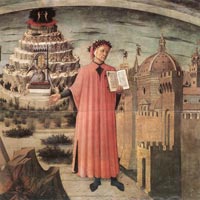 Dante, poised between the mountain of purgatory and the city of Florence, displays the famous incipit Nel mezzo del cammin di nostra vita in a detail of Domenico di Michelino's painting, Florence 1465 [1] 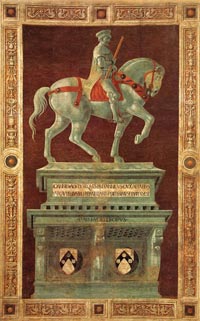 Paolo Ucello, Funerary Monument to Paolo Ucello, Funerary Monument to Sir John Hawkwood |
|
Chiesa di San Miniato al Monte |
||
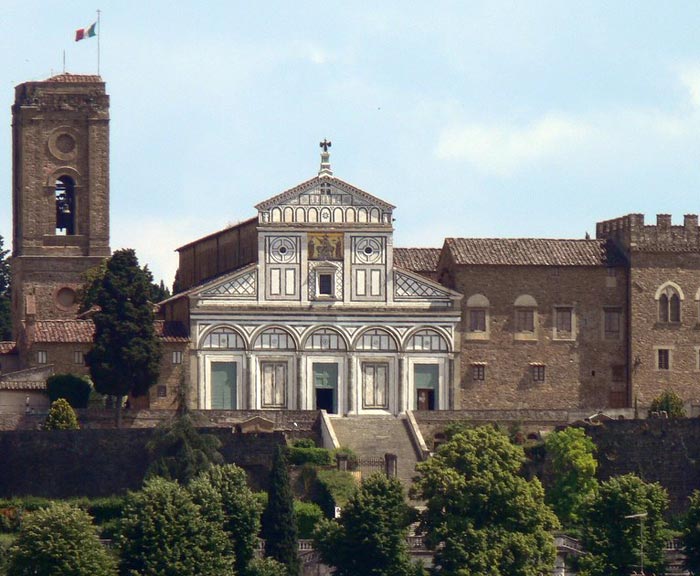 |
||
San Miniato al Monte faces Florence from across the Arno |
||
The Basilica of San Miniato al Monte is one of the oldest churches in Florence and is frequently called the finest Romanesque basilica in all of Italy. The church as we know it today was started around 1018 and took over one hundred years to complete. St. Minias was possibly from Armenia and believed to have been martyred around 250 (he was beheaded during the anti-Christian persecutions of the Emperor Decius and was said to have picked up his head, crossed the Arno and walked up the hill of Mons Fiorentinus to his hermitage and buried on this hillside). The church is in a wonderful state of preservation and there are several important works inside, including a tabernacle attributed to Rossellino, the tomb of the Cardinal of Portugal with works by Rossellino, Della Robbia and others, frescoes by Agnolo Gaddi, and an amazing fresco cycle of the life of St. Benedict by Spinello Aretino, to name just some of them. Art in Tuscany | Florence | Basilica of San Miniato al Monte
|
||
Santa Maria del Carmine |
||
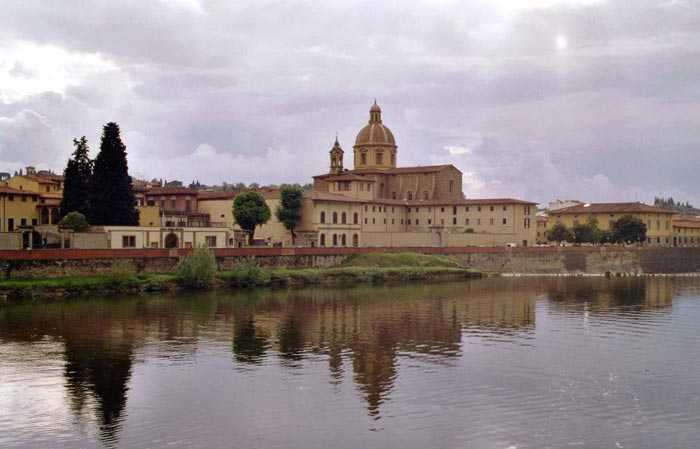 |
||
Chiesa di Santa Maria del Carmine in Firenze
|
||
| Santa Maria del Carmine is a church of the Carmelite Order. It is famous for its Brancacci Chapel which houses magnificent Renaissance frescoes by Masaccio and Masolino da Panicale, later finished by Filippino Lippi.
The church, dedicated to the Beatæ Virginis Mariæ de monte Carmelo, began to be built in 1268 as part of the Carmelite convent, which still exists today. Of the original edifice Some Romanesque-Gothic remains of the original structure can still be seen on the sides of the church. The complex was enlarged once in 1328 and again in 1464, when the capitular hall and the refectory were added. Renovated again in 16th-17th centuries, the church was damaged by a fire in 1771 and rebuilt internally in 1782. The façade, like many other Florentine churches, remained unfinished. The fire did not touch the sacristy and fortunately many artworks survived, including the stories of St. Cecilia attributed to Lippo d'Andrea and the marble monument of Pier Soderini by Benedetto da Rovezzano. The vault of the nave has a trompe-l'oeil fresco by Domenico Stagi. The Brancacci Chapel also survived the fire and was also restored due to the intervention of a Florentine noblewoman who firmly opposed the covering of the frescoes. The Chapel is home to famous frescoes by Masaccio and Masolino, considered the first masterworks of the Italian Renaissance. Masaccio's master, Masolino, commissioned by a wealthy merchant, Felice Brancacci, began work on the chapel in 1425 but the project was soon taken over by his pupil whose treatment of figures in space made the frescoes among the most important to have come out of the Early Renaissance. The scenes by Masaccio are the Expulsion from Paradise, The Tribute Money St Peter Healing a Lame-Man, and St Peter Raising Tabitha from the dead. The cycle was finished by Filippino Lippi. The Corsini Chapel of the church was built by the Corsini, probably the richest family in Florence during the 17th-18th centuries. The chapel is dedicated to St. Andrew Corsini, a Carmelite bishop of Fiesole who was canonized in 1629. The architect Pier Francesco Silvani choose a Baroque style for the chapel. The small dome was painted by Luca Giordano in 1682. The elaborated rococo ceiling is the work of one of the most important 18th century artists in the city, Giovanni Domenico Ferretti. The convent of the church has suffered several times from numerous disasters, from the fire to the flooding of 1966. Most of the artworks are therefore damaged: these include the Bestowal of the Carmelite Rule by Filippo Lippi and the Last Supper by Alessandro Allori, and remains of works from other chapels by Pietro Nelli and Gherardo Starnina. Churches in Florence | Santa Maria del Carmine Art in Tuscany | Masaccio | Brancacci Chapel in Santa Maria del Carmine, Florence |
||
Santa Maria Novella |
||
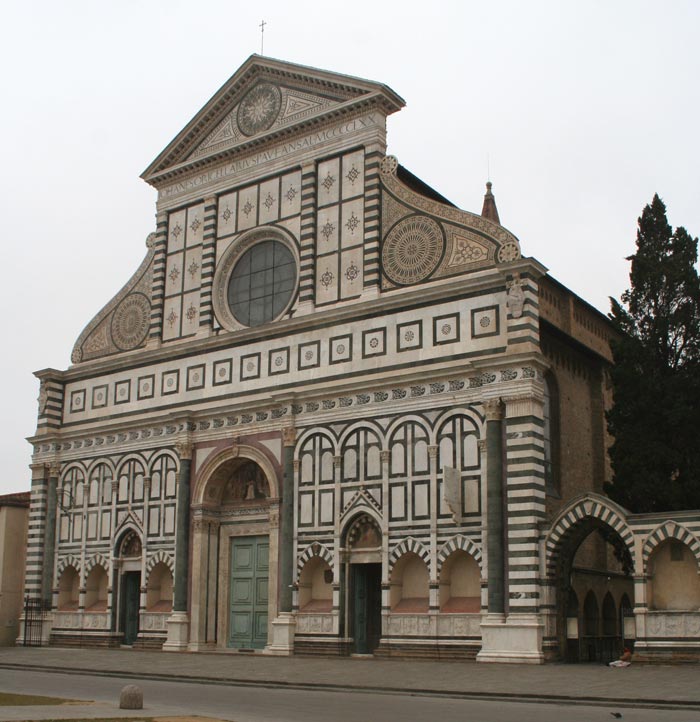 |
||
Santa Maria Novella |
||
The decorative marble facade of Tuscany's most important Gothic church incorporates billowing sails and ostrich feathers (emblem of the Medici). The Santa Maria Novella church houses immense artistic treasures, donated by wealthy patrons, many with chapels named after them. The old church on this site, taken over in 1219 by a group of Dominicans led by Fra Giovanni da Salerno, was called Santa Maria della Vigne (the nearby Duomo was Santa Maria del Fiore). The foundation stone of the present church was laid in October 1279, and the church was finally consecrated 140 years later in September 1420. The exterior is the work of Fra Jacopo Talenti and Leon Battista Alberti. The interior holds extraordinary works of art including Masaccio's Trinità, Ghirlandaio's fresco cycle in the Tornabuoni Chapel and Giotto's Crucifix, among others. The convent was built between 1279 and 1357 by Dominican friars near a 7th century church located in the fields just outside Florence's medieval walls. The lower part of the marble facade, which is Romanesque in style, is believed to have been executed by a Dominican architect, Fra Iacopo Talenti da Nipozzano, while the upper part was completed only 100 years later in 1470 by Leon Battista Alberti. Thus, the facade is not only the oldest of all the churches in Florence but it is also the only church with its original planned facade in place. As you will see, the church of San Lorenzo never even received its planned marble facade while others were completed centuries later with new designs. |
||
The church initially had been divided into two parts - the higher part was divided by a wall and reserved for the friars while the lower part was open to the faithful that entered by the eastern side door. The wall was demolished by Vasari in the 16th century but you can clearly see where the division used to be as Giotto's Crucifix hangs right above. This also explains why the pulpit is so far down the church in the lower part. The side door was also closed off by Vasari and was just reopened in 2000 on occasion of the Jubilee celebrations which permits once again to correctly observe Masaccio's Trinity as it was intended. |
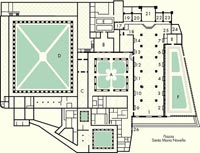 |
|
The Trinità or Trinity by Masaccio on the far wall right in front of you as you enter the church through the side door. The Trinità (1424-25) is one of the earliest paintings to demonstrate mastery of perspective. Also notice that the Virgin Mary is not portrayed as a young girl as in so many other paintings; here, she is older and is clearly a mother. |
||
| Church of Saint Apostoli |
||
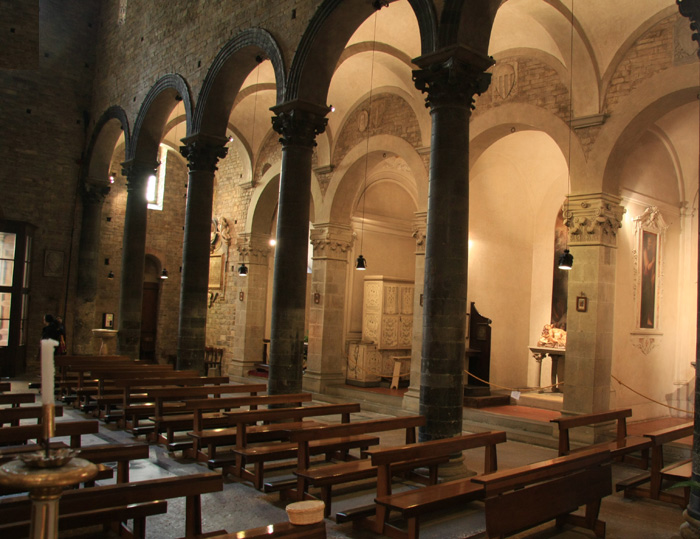 |
||
Church of Saint Apostoli, interior |
||
| The Church of Saint Apostoli was built in the 11th century, and, though remodelled in the 15th and 16th centuries, is one of the few in the city to have maintained its High Middle Ages features. It faces the Piazza del Limbo ("Limbo Square), so-called for it anciently housed a cemetery for children who died before having been baptized. A slab on the façade attributes the foundation to Charlemagne and his paladin Roland, in the year 800, but scholars assign it to the 11th century. A small bell tower was added by Baccio d'Agnolo in the 16th century. The simple façade, in Romanesque style, has a portal attributed to Benedetto da Rovezzano. Interior The plan, with a nave and two aisles with a semicircular apse, still shows Palaeo-Christian influences. It has green marble columns from Prato with capitals stripped from ancient Roman remains (the Corinthian ones probably coming from the baths existing in the area). The richly decorated wooden ceiling was added in 1333. Noteweorthy is the pavement, with a mosaic from the original edifice which was later restored with the contributions of outstanding Florentine families (Acciaioli, Altoviti and others). the apse area has maintained the Romanesque appearance, with undecorated stones visible. The side chapels are from the 16th century. In the church are conserved some stone splinters from the Holy Sepulchre which are used as a flint to light the fire-works during the "Scoppio del Carro" feast on Easter Sunday, in front of the Baptistery. On the left of the apse are a polychrome terracotta tabernacle by Giovanni della Robbia, and the Tomb of Oddo Altoviti (who financed most of the reconstructions) by Benedetto da Rovezzano. The tomb of Bindo Altoviti has a bust by Bartolomeo Ammannati (1570). |
||
Santa Croce
|
||
|
||
Firenze, Santa Croce |
||
Santa Croce, rebuilt for the Franciscan order in 1294 by Arnolfo di Cambio, is the burial place for the great and good in Florence. Michelangelo is buried in Santa Croce, as are Rossini, Machiavelli, and the Pisan-born Galileo Galilei, who was tried by the Inquisition and was not allowed a Christian burial until 1737, 95 years after his death. |
||
Orsanmichele |
||
| Orsanmichele (or "Kitchen Garden of St. Michael", from the contraction in Tuscan dialect of the Italian word orto) was constructed on the site of the kitchen garden of the monastery of San Michele, now gone. Located on the Via Calzaiuoli in Florence, the church was originally built as a grain market in 1337 by Francesco Talenti, Neri di Fioravante, and Benci di Cione. Between 1380 and 1404 it was converted into a church used as the chapel of Florence's powerful craft and trade guilds. On the ground floor of the square building are the 13th century arches that originally formed the loggia of the grain market. The second floor was devoted to offices, while the third housed one of the city's municipal grain storehouses, maintained to withstand famine or siege. Late in the 14th century, the guilds were charged by the city to commission statues of their patron saints to embellish the facades of the church. The sculptures seen today are copies, the originals having been removed to museums. Inside the church is Andrea Orcagna's bejeweled Gothic Tabernacle (1355-59) encasing a repainting by Bernardo Daddi's of an older icon of the 'Madonna and Child'. The facades held 14 architecturally designed external niches, which were filled from 1399 to around 1430. The three richest guilds opted to make their figures in the far more costly bronze, which cost approximately ten times the amount of the stone figures. |
||
The Badia Fiorentina |
||
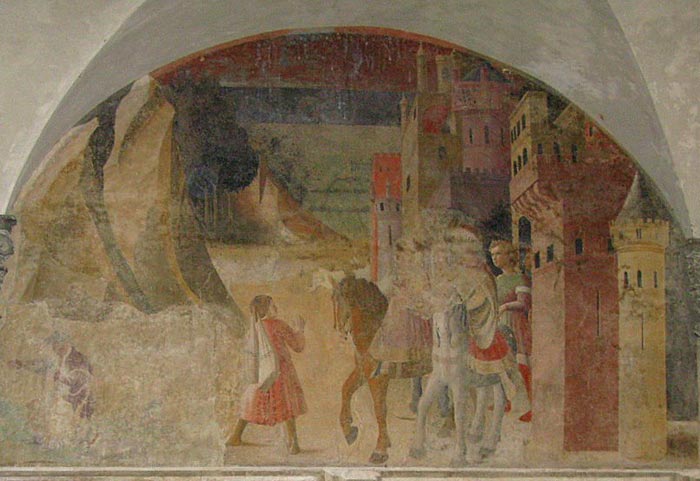 |
||
The Badia Fiorentina, frescoes by Nardo di Cione |
||
The Badia Fiorentina, the pointy tower in Dante's neighborhood is one of the nicest (and least visited) older churches in Florence. It was founded as a Benedictine abbey in the late 10th century, and rebuilt as a Gothic church in 1284–1310. The interior has an unfortunately uninspired baroque overlay. The Badia helped regulate life in medieval Florence through the tolling of its bell, which marked the beginning and end of the working day. |
||
| The high point of the early phase of Lippi's development is the Vision of St Bernard, one of the finest lyric pictures of the entire Renaissance. The painting was commissioned by Piero del Pugliese, a wealthy cloth merchant, whose portrait we see in the bottom right hand corner. St Bernard of Clairvaux, seated at a desk with his pen poised, experiences a vision of the Virgin, who regularly had been the subject of his writings. The confrontation takes place out-of-doors (rather than in his study or in a church), enframed ingeniously by an outcropping of rock that creates a natural bench and bookshelves for the scholar. Behind Bernard, in the dark reaches of the rock, are two chained demons, while in the zone above, Cistercian monks converse or look heavenward in front of their fine Renaissance abbey. Still higher in the composition, a sick old man is being carried down toward the building. On the other side, a sweet landscape sweeps the eye into the distance. The format of the main figural group is echoed by the stony backdrop which, roughly speaking, forms a pyramid. Also included are the donor, Francesco del Pugliese, matched pictorially on the other side by the blond angel, leaning inward, hands clasped in prayer. The colours are confident, bright, and direct, adding to the exceptional visual excitement of the painting. Mary hovers above the ground facing Bernard. Her elegant form and finely silhouetted head are not dependent upon vigorous light-to-dark juxtapositions or even, as with Botticelli, a felicitously found, heavily accented line, but rather on the operation of fragile edges. The same is true for the figure of the saint, where light, colour, and lustrous paint, presumably oil, combine to produce the desired effect. The landscape is rather flat, despite all the implications of deep space. The painting, although not dated, may have been finished by 1485, the approximate completion date for another project of considerable importance, the Brancacci Chapel frescoes. |
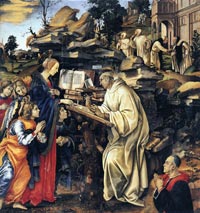 Filippino Lippi, Apparition of The Virgin to St Bernard, 1486, Church of Badia, Florence |
|
Basilica di San Lorenzo |
||
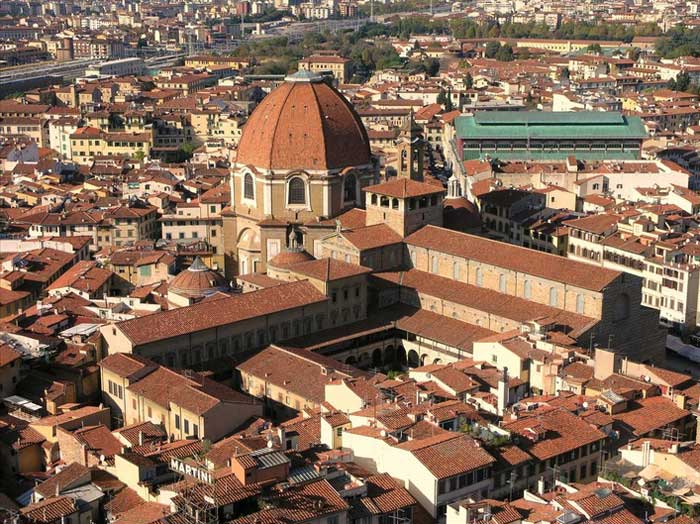 |
||
Basilica di San Lorenzo
|
||
The Basilica di San Lorenzo was also the site of the most influential architectural innovations of the Renaissance: the Old Sacristy designed by Brunelleschi and decorated by Donatello is the first architecture based on proportion, the unity of elements, and the use of classical orders. It was financed by the Medici, who used it for their tombs, and it is one of the most important monuments of early Renaissance architecture. |
||
The two Pulpits with eleven panels in the Basilica of San Lorenzo are Donatello's last works. The chronology is known because the date "1465 adi 15 Gug" (on 15 June 1465) was traced on the ledge of the pulpit to the left of the Torture of St Lawrence. The two bronze pulpits were the scene of Savanarola’s fire and brimstone sermons. |
||
The St. Trinity Church, or Church of Santa Trinita |
||
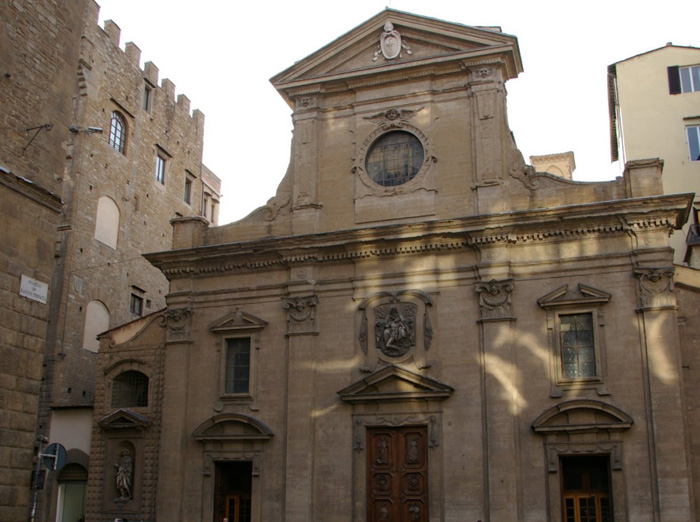 |
||
Basilica of Santa Trinita, Florence |
||
The Church of Santa Trinita, or St. Trinity Church, overlooks the square of the same name and can easily be reached by walking down via de' Tornabuoni, one of the most elegant streets in Florence's city center, down towards the Arno River. |
||
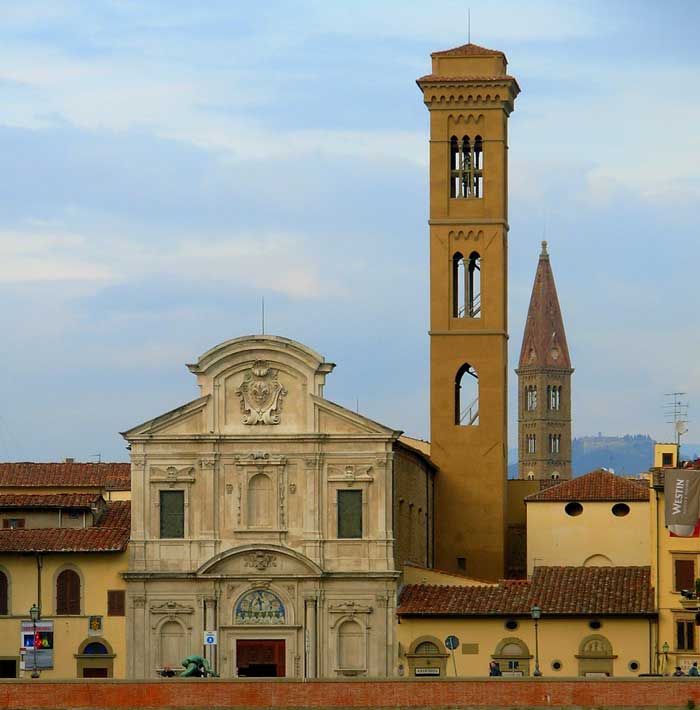 |
||
Chiesa di Ognissanti
|
||
| The Chiesa di Ognissanti (All-Saints Church) is a Franciscan church in Florence, Italy. Founded by the lay order of the Umiliati, the church was dedicated to all the saints and martyrs, known and unknown. It was completed during the 1250s, but almost completely rebuilt on Baroque designs of Bartolomeo Pettirossi, about 1627, with a façade - by Matteo Nigetti (1637) - that conserved the grand glazed terracotta lunette in the manner of the Della Robbia, now attributed to Benedetto Buglioni, over the doorway: Ognissanti was among the first examples of Baroque architecture to penetrate this Renaissance city. Its two orders of pilasters enclose niches and windows with fantastical cornices. To the left of the façade is a campanile of 13th and 14th century construction. The Umiliati, by the dedication and probity of the lay brothers and sisters, gained a reputation in Florence, and dedicated works of art began to accumulate in their severely simple church. Giotto's celebrated Madonna and Child with angels, now in the Uffizi, was painted for the high altar, about 1310, and recently, cleaning has also revealed Giotto's hand in the Crucifix in the left transept. During the sixteenth century the Umiliati declined in energy, and the Franciscan order assumed control of the church in 1571, bringing precious relics such as the robe Saint Francis of Assisi wore. In the interior, the Baroque remodelling, which provided a completely rebuilt apse with a pietre dure high altar and a sotto in su perspective (1770) on the vaulted nave ceiling, preserved quattrocento frescoes in the nave chapels, by Ghirlandaio and Botticelli, who is buried in the church near his beloved Simonetta Vespucci. Botticelli's fresco of Saint Augustine in his Study, balances Ghirlandaio's Saint Jerome in his Study in the chapel facing it across the navel, both executed in 1480. Perhaps the greatest of Ognissanti's frescoes is Ghirlandaio's Last Supper in the refectory between the two cloisters, a work with which Leonardo was intimately familiar. In the Vespucci chapel, a fresco by Domenico Ghirlandaio with his brother David (about 1472), of the Madonna della Misericordia protecting members of the Vespucci family, is reputed to include the portrait of Amerigo Vespucci as a child. Art in Tuscany | Firenze | Chiesa di Ognissanti |
||
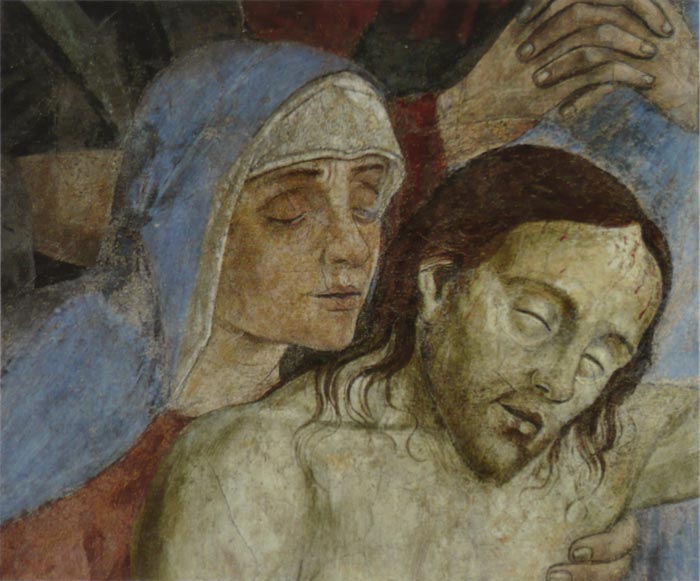 |
||
The Basilica della Santissima Annunziata |
||
| One of the most beautiful piazzas in Florence, Piazza della Santissima Annunziata exemplifies the stylistic harmony of some of the greatest architects of the Renaissance. The church that gives the piazza its name, the Santissima Annunziata, lies behind the central portico of the piazza. The Basilica della Santissima Annunziata (Basilica of the Most Holy Annunciation) is a Roman Catholic minor basilica in Florence and the mother church of the Servite order. It is located at the northeastern side of the Piazza Santissima Annunziata. |
||
'One of the most highly venerated Marian shrines in Florence, the church was founded in 1250 as the Oratory of Cafaggio, by the Seven Holy Founders of the Servite Order. These noble Florentines, having been vouchsafed a vision of the Virgin, retired from the city to a wild hermitage at Monte Senario, north of Florence. |
||
Other churches in Florence |
||
Chiesa di Santa Felicita |
||
The oldest church of Oltrarno, the Chiesa di Santa Felicita, is renown for the masterpiece of Mannerist painting exposed in one of its chapels, the Deposition by Pontormo. During the centuries this church had many alterations before Ferdinando Ruggieri, in 1736, gave it its present appearance. In 4th Century a church was built on this place by the Christian community of Florence, which inhabitated on this side of the river, opposite to the Roman city; this early-christian building was subsequently modified and enlarged (in 11th Century, and then in 14th Century, when a tower located by the church was transformed in bell-tower), so that today only few fragments of the originary structure are still recognizable. |
||
| Santa Lucia dei Magnoli is small and very old church flanked by the palaces of Via de' Bardi. Following a tradition, Saint Francis of Assisi and Saint Domenico met in 1211 in the hospital that was located at the side of the church. The church was founded in 1078 on the initiative of the noblesman Uguccione della Pressa, and was once known also under the names of Santa Lucia dei Bardi (from the most important family of the quarter) or Santa Lucia delle Rovinate (referring to the landslips of the near hill of San Giorgio). In 15th Century the church passed under the protection of the family Da Uzzano, who had built a palace near the church palazzo (today Palazzo Capponi delle Rovinate) and subventioned the frescoes in the main chapel. Other noble families (among them, Capponi and Mozzi) contributed to the decoration of the church: their coats of arms are to be seen on the façade and in the interior of the church. Santa Lucia was frequently damaged by the landslpis of the hill of San Giorgio, and was rebuilt (and modified) in 1732, but subsequent restorations in 19th and 20th Centuries re-discovered the structure and decorations of the 15th Century. The façade was restored a few years ago. Walking in Tuscany | Florence | San Niccolo Neighbourhood in Oltrarno |
||
The Chiesa di San Jacopo Soprarno shows elements from different periods and styles - from Romanesque to Baroque. The San Jacopo in Soprarno was built in the 10th-11th century in Romanesque style. The church experienced heavy modifications, including the addition of a triple-arched portico; the has a Romanesque 12-13th century three-arched loggia taken from San Donato in Scopeto, which was destroyed in the siege of 1529. According to the Renaissance art historian Giorgio Vasari, Filippo Brunelleschi built here a chapel, the Ridolfi Chapel, in which he studied, in smaller scale, architectural elements later later used in his famous dome of Santa Maria del Fiore. The chapel is now destroyed. Since 1542 it was held by Franciscans of the Minorite Order. The entrance portico was remade by order of Cosimo I de' Medici in 1580. The bell tower was designed by Gherardo Silvani in 1660. The church was damaged when the Arno River flooded Florence in 1966. Repairs of the church after flood led to the restoration of some of the historical architectural features[1], and the discover of columns belonging to the original Romanesque church in the Baroque interior. |
||
The Basilica della Santissima Annunziata (Basilica of the Most Holy Annunciation ) stands in a Renaissance piazza with rounded porticoes and fine decoration. In the center, there is the equestrian statue of the Grand Duke Ferdinand I, a work from 1608 by Pietro Tacca who was responsible for the very original bronze fountains alongside. The church itself was founded in 1260 to be the Oratory of the Servants of Mary. However, it was very soon renovated and enlarged because of growing devotion to the fresco of the Annunciation. The present church is preceded by a portico that leads you into the so-called "small cloister of votive tablets" and you pass from here into the main church which consists of one single nave with side chapels and a large round tribune at the end. The interior was reconstructed in the mid 15th century, and renewed again in the second half of the 17th in a sumptuous Baroque style. Particularly worthy of note is the wooden ceiling, decorated in gold with paintings and precious in-lay carvings. The front piece of the high altar is a splendid work in silver made by the Grand Duke's silversmith, Cosimo Merlini, an artist with Baroque tastes. |
|
|
This Chiostro dello Scalzo forms the entrance to the chapel of the Confraternity of the Disciplinati of St John the Baptist, known as the Cloister of the Scalzo, founded in 1376. At various intervals between 1509 and 1526, the great Florentine artist Andrea del Sarto painted the walls with frescoes depicting Scenes from the life of St John the Baptist and the Virtues, except for two episodes that were painted by Franciabigio. It is called "dello Scalzo" (barefoot) because the friar holding the cross used to go barefoot. The Chiostro dello Scalzo really shows Andrea del Sarto's painting path: it is an absolute masterpiece in the constant dialogue of space, architecture and figures highlighted by the use of monochrome. Address: Chiostro dello Scalzo, Via Cavour 69. |
||
The Chiesa Santo Stefano al Ponte is a church in Florence. The church was originally constructed in the 11th and 12th century in a Romanesque style with a polychrome marble facade. The annexed Diocesan Museum houses a panel with a Madonna by Giotto and exhibits works of art taken from other churches in town and in the territory of the diocese of Florence. The Church of Santo Stefano al Ponte Vecchio was badly damaged during the second world war, and again by the 1966 flood. It has a main entrance, which has a two-colored stone molding, dating back to late 13th century. The interior is rectangular, and originally had three aisles, which were merged into a single nave by F. Tacca between 1649 and 1655. The roof has exposed trellisbeams that are at two different elevations. The church has now been deconsecrated, and hosts the Orchestra Regionale Toscana. |
||
Santa Maria Maddalena dei Pazzi is a religious complex in central Florence, Italy, including a church and a former convent in Borgo Pinti. The entrance to this church is an unassuming, unnumbered door on Borgo Pinti that opens onto a cloister designed by Giuliano da Sangallo in 1492. Open |
||
|
||||
Travel guide for tuscany | Art, history, hidden secrets and holiday homes in Tuscany | Podere Santa Pia |
||||
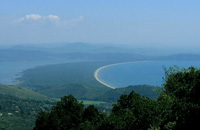 |
||||
Podere Santa Pia |
Podere Santa Pia, garden view, April |
Monte Argentario, Tombolo di Feniglia
|
||
Monteriggioni |
Castiglioncello Bandini |
Montalcino | ||
The Oratory of Santa Caterina in Bagno a Ripoli |
||||
Not far from the Baroncelli hills, along the panoramic Via del Carota in Ponte a Ema, we find the Santa Caterina delle Ruote a Rimezzano Oratory, gem of Bagno a Ripoli. |
 The frescoed cyclesin the Oratorio di S. Caterina degli Alberti in Bagno a Ripoli portray scenes from the life of Saint Catherine of Alexandria.
|
|||
Montefalco |
Piazza della Santissima Annunziata in Florence |
Florence, Duomo |
||
|
||||

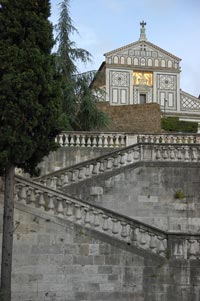
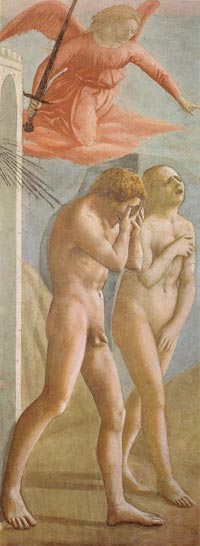
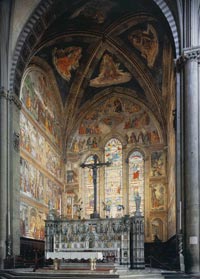
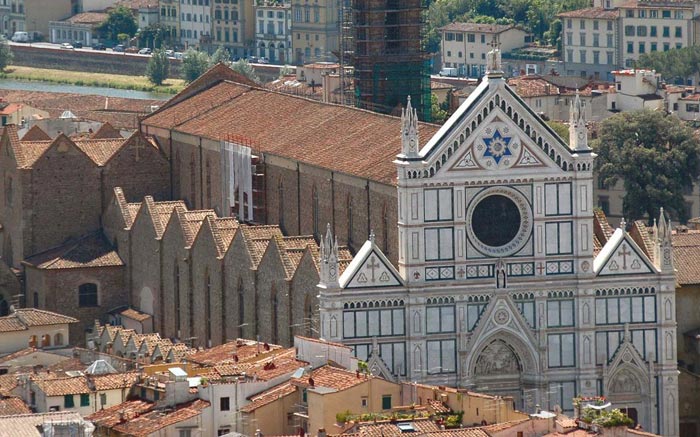
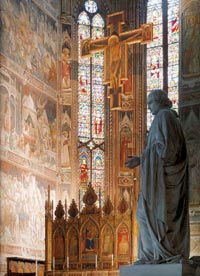
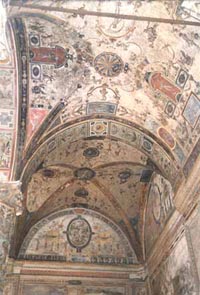
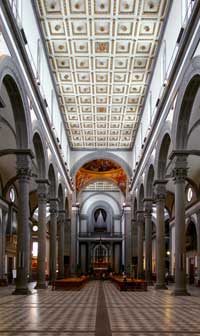
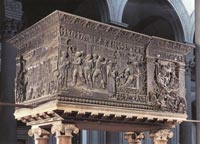
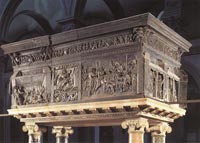
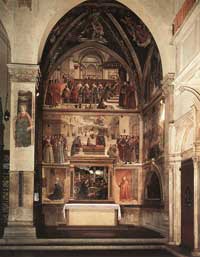
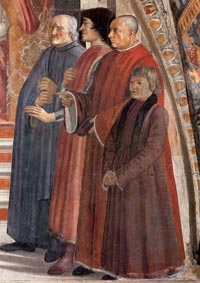
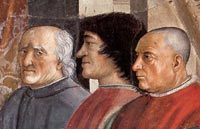
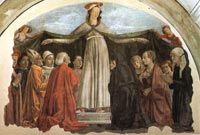
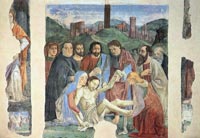
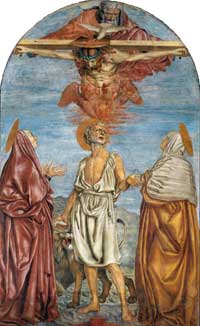
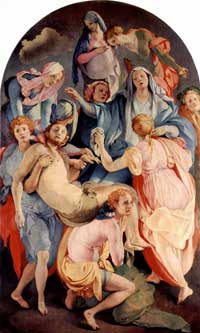
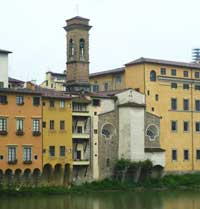
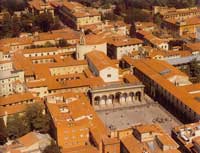 Basilica della Santissima Annunziata
Basilica della Santissima Annunziata